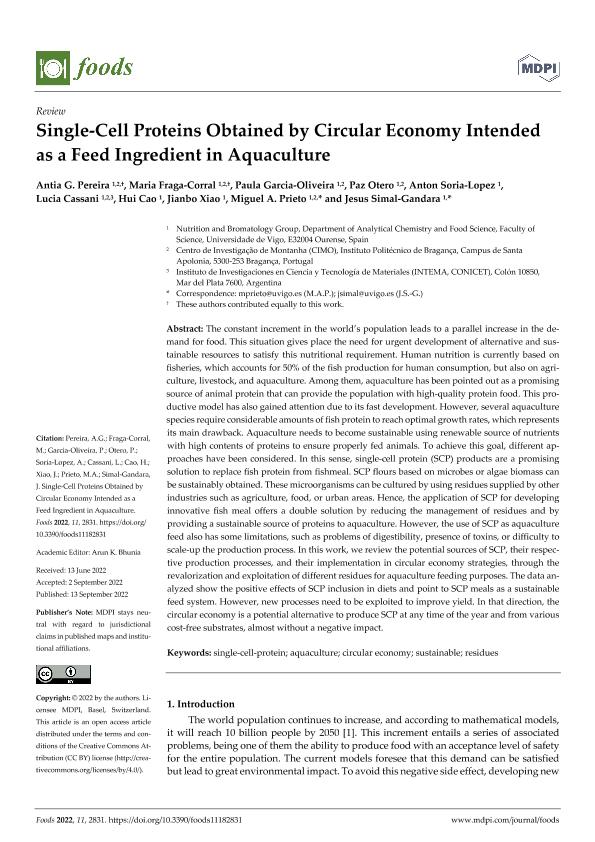Mostrar el registro sencillo del ítem
dc.contributor.author
Pereira, Antia G.
dc.contributor.author
Fraga Corral, Maria
dc.contributor.author
Garcia Oliveira, Paula
dc.contributor.author
Otero, Paz
dc.contributor.author
Soria Lopez, Anton
dc.contributor.author
Cassani, Lucía Victoria

dc.contributor.author
Cao, Hui
dc.contributor.author
Xiao, Jianbo
dc.contributor.author
Prieto, Miguel A.
dc.contributor.author
Simal Gándara, Jesús

dc.date.available
2023-09-20T13:20:39Z
dc.date.issued
2022-09
dc.identifier.citation
Pereira, Antia G.; Fraga Corral, Maria; Garcia Oliveira, Paula; Otero, Paz; Soria Lopez, Anton; et al.; Single-Cell Proteins Obtained by Circular Economy Intended as a Feed Ingredient in Aquaculture; Multidisciplinary Digital Publishing Institute; Foods; 11; 18; 9-2022; 1-22
dc.identifier.uri
http://hdl.handle.net/11336/212254
dc.description.abstract
The constant increment in the world’s population leads to a parallel increase in the demand for food. This situation gives place the need for urgent development of alternative and sustainable resources to satisfy this nutritional requirement. Human nutrition is currently based on fisheries, which accounts for 50% of the fish production for human consumption, but also on agriculture, livestock, and aquaculture. Among them, aquaculture has been pointed out as a promising source of animal protein that can provide the population with high-quality protein food. This productive model has also gained attention due to its fast development. However, several aquaculture species require considerable amounts of fish protein to reach optimal growth rates, which represents its main drawback. Aquaculture needs to become sustainable using renewable source of nutrients with high contents of proteins to ensure properly fed animals. To achieve this goal, different approaches have been considered. In this sense, single-cell protein (SCP) products are a promising solution to replace fish protein from fishmeal. SCP flours based on microbes or algae biomass can be sustainably obtained. These microorganisms can be cultured by using residues supplied by other industries such as agriculture, food, or urban areas. Hence, the application of SCP for developing innovative fish meal offers a double solution by reducing the management of residues and by providing a sustainable source of proteins to aquaculture. However, the use of SCP as aquaculture feed also has some limitations, such as problems of digestibility, presence of toxins, or difficulty to scale-up the production process. In this work, we review the potential sources of SCP, their respective production processes, and their implementation in circular economy strategies, through the revalorization and exploitation of different residues for aquaculture feeding purposes. The data analyzed show the positive effects of SCP inclusion in diets and point to SCP meals as a sustainable feed system. However, new processes need to be exploited to improve yield. In that direction, the circular economy is a potential alternative to produce SCP at any time of the year and from various cost-free substrates, almost without a negative impact.
dc.format
application/pdf
dc.language.iso
eng
dc.publisher
Multidisciplinary Digital Publishing Institute
dc.rights
info:eu-repo/semantics/openAccess
dc.rights.uri
https://creativecommons.org/licenses/by/2.5/ar/
dc.subject
AQUACULTURE
dc.subject
CIRCULAR ECONOMY
dc.subject
RESIDUES
dc.subject
SINGLE-CELL-PROTEIN
dc.subject
SUSTAINABLE
dc.subject.classification
Alimentos y Bebidas

dc.subject.classification
Otras Ingenierías y Tecnologías

dc.subject.classification
INGENIERÍAS Y TECNOLOGÍAS

dc.title
Single-Cell Proteins Obtained by Circular Economy Intended as a Feed Ingredient in Aquaculture
dc.type
info:eu-repo/semantics/article
dc.type
info:ar-repo/semantics/artículo
dc.type
info:eu-repo/semantics/publishedVersion
dc.date.updated
2023-06-23T16:34:17Z
dc.identifier.eissn
2304-8158
dc.journal.volume
11
dc.journal.number
18
dc.journal.pagination
1-22
dc.journal.pais
Suiza

dc.description.fil
Fil: Pereira, Antia G.. Universidad de Vigo; España. Instituto Politécnico de Bragança; Portugal
dc.description.fil
Fil: Fraga Corral, Maria. Instituto Politécnico de Bragança; Portugal. Universidad de Vigo; España
dc.description.fil
Fil: Garcia Oliveira, Paula. Universidad de Vigo; España. Instituto Politécnico de Bragança; Portugal
dc.description.fil
Fil: Otero, Paz. Universidad de Vigo; España. Instituto Politécnico de Bragança; Portugal
dc.description.fil
Fil: Soria Lopez, Anton. Universidad de Vigo; España
dc.description.fil
Fil: Cassani, Lucía Victoria. Instituto Politécnico de Bragança; Portugal. Universidad de Vigo; España. Consejo Nacional de Investigaciones Científicas y Técnicas; Argentina
dc.description.fil
Fil: Cao, Hui. Universidad de Vigo; España
dc.description.fil
Fil: Xiao, Jianbo. Universidad de Vigo; España
dc.description.fil
Fil: Prieto, Miguel A.. Instituto Politecnico de Braganca; Portugal. Universidad de Vigo; España
dc.description.fil
Fil: Simal Gándara, Jesús. Universidad de Vigo; España
dc.journal.title
Foods
dc.relation.alternativeid
info:eu-repo/semantics/altIdentifier/doi/http://dx.doi.org/10.3390/foods11182831
dc.relation.alternativeid
info:eu-repo/semantics/altIdentifier/url/https://www.mdpi.com/2304-8158/11/18/2831
Archivos asociados
